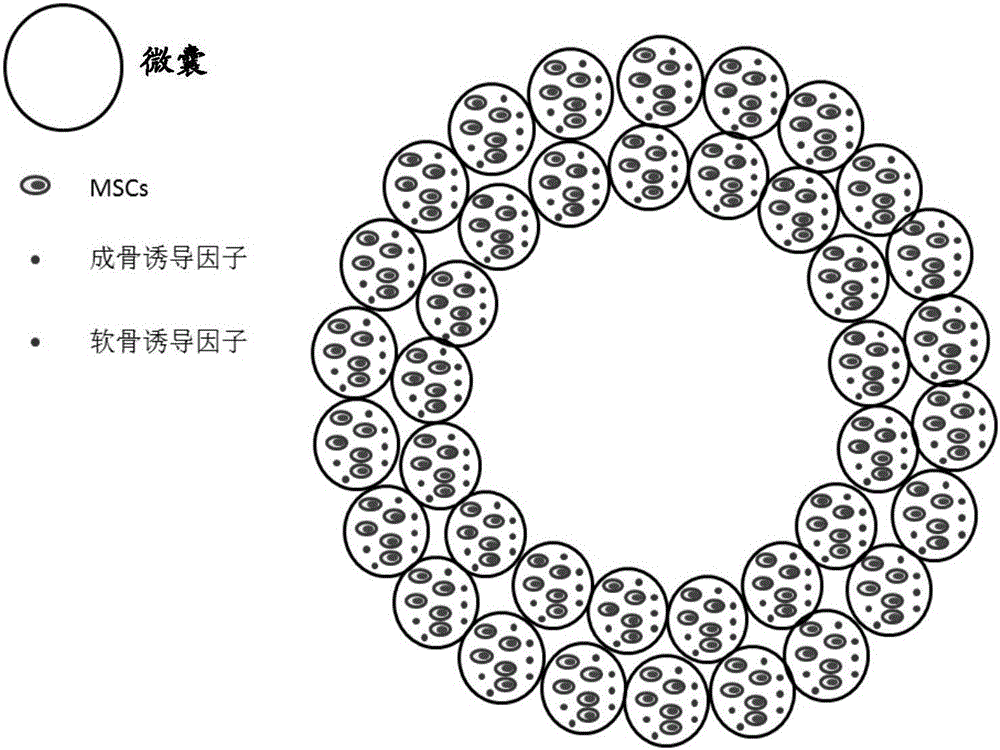Preparation method of composite structure
A technology of composite structures and constructs, applied in the field of biology, can solve the problems of increasing the risk of contamination, long time consumption, different culture systems, etc.
- Summary
- Abstract
- Description
- Claims
- Application Information
AI Technical Summary
Problems solved by technology
Method used
Image
Examples
specific Embodiment approach
[0285]The invention will now be described with reference to the following examples, which are intended to illustrate the invention, but not to limit it.
[0286] Reagents, kits or instruments whose sources are not specified in the examples are all conventional products commercially available on the market. Those skilled in the art understand that the examples describe the present invention by way of example and are not intended to limit the scope of the claimed invention.
Embodiment 1
[0287] Embodiment 1. Preparation of microcapsules
[0288] This example provides an exemplary method for preparing microcapsules. The preparation method of microcapsules should be carried out under sterile conditions. In addition, if the microcapsules are intended to be applied to the human body, the biosafety level of the preparation method should reach the GMP workshop level.
[0289] The instrument used in this method is a granulator (BUCHI, Encapsulator, B-395Pro), and the diameters of the concentric nozzles it is equipped with are as follows: the inner layer nozzle, 200 μm; the outer layer nozzle, 300 μm.
[0290] The materials used in this method are as follows:
[0291] (1) Materials used to prepare the nuclear layer
[0292] Type I collagen: 4mg / ml, neutralized with sterile 1M NaOH;
[0293] Sodium alginate: Dissolve and dilute with deionized water;
[0294] Vascular endothelial growth factor VEGF;
[0295] Type I collagen was mixed with 2% (w / v) (ie, 2 g / 100 ml,...
Embodiment 2
[0305] Example 2. Characterization of microcapsules
[0306] This example specifically analyzes the properties of the microcapsules prepared by the method in Example 1, including the size of the microcapsules, the thickness of the shell layer, the mechanical protection, the number of cells contained therein, and the like.
[0307] Use a microscope to observe the microcapsules prepared by the method of Example 1, the results are shown in Figures 3A-3C middle. Figures 3A-3C Micrographs of microcapsules prepared using a granulator under different instrument parameters (diameters of the inner and outer nozzles of the concentric nozzles) are shown, where, Figure 3A The diameter of the microcapsules in is about 120 μm (the scale bar is 100 μm); Figure 3B The diameter of the microcapsules in is about 200 μm (the scale bar is 100 μm); Figure 3C The diameter of the microcapsules in is about 450 μm (bar is 200 μm). These results suggest that the size of the microcapsules can be...
PUM
| Property | Measurement | Unit |
|---|---|---|
| Thickness | aaaaa | aaaaa |
| Elastic modulus | aaaaa | aaaaa |
| Hardness | aaaaa | aaaaa |
Abstract
Description
Claims
Application Information
 Login to View More
Login to View More - R&D
- Intellectual Property
- Life Sciences
- Materials
- Tech Scout
- Unparalleled Data Quality
- Higher Quality Content
- 60% Fewer Hallucinations
Browse by: Latest US Patents, China's latest patents, Technical Efficacy Thesaurus, Application Domain, Technology Topic, Popular Technical Reports.
© 2025 PatSnap. All rights reserved.Legal|Privacy policy|Modern Slavery Act Transparency Statement|Sitemap|About US| Contact US: help@patsnap.com



